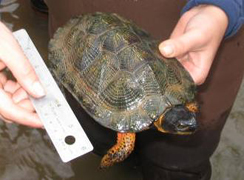Endangered and Threatened Species Alert:
Survey Window for the State-Threatened Wood Turtle Opens Soon
If your Virginia project site includes a clear, moderate- to fast-flowing perennial stream and a relatively undisturbed floodplain, it may be home to the wood turtle (Glyptemys insculpta). As a state-threatened species in Virginia, the wood turtle is protected by state endangered species laws. You can minimize the impact this species can have on your project schedule by having Wetland Studies and Solutions conduct a wood turtle survey early in the development process – preferably when the turtle enters the aquatic phase from approximately November to early April (depending on water temperatures).

WSSI scientist handling a wood turtle.
Though the wood turtle is considered uncommon in Virginia, the Virginia Department of Environmental Quality (DEQ) must consider potential impacts to this species before issuing permits to impact wetlands and other jurisdictional waters. The Department of Game and Inland Fisheries (DGIF) recommends that we conduct a wood turtle survey on project sites where suitable habitat is present, within any county of known or likely occurrence.
Where is the Wood Turtle?
This semi-aquatic turtle is found in the eastern United States from Canada to Virginia, with northern Virginia and the Shenandoah Valley representing the southern limit of its range. The wood turtle is not considered a threatened or endangered species in Maryland and is not found in North Carolina.
Virginia localities where wood turtle is known or likely¹:
- Fairfax County
- Loudoun County
- City of Alexandria
- Clarke County
- Frederick County
- Rockingham County
- Shenandoah County
- Warren County
- Page County
We can help!
Wetland Studies and Solutions has DGIF-approved wood turtle surveyors on staff, and we have conducted many habitat evaluations and surveys for this species throughout Virginia. We can conduct preliminary (and relatively inexpensive) site evaluations at any time of year to determine whether there is potentially suitable habitat for wood turtle on your project site – and for some sites, this habitat evaluation may be all that is necessary to confirm absence of the species.
Contact us to schedule your wood turtle survey now and keep this species from delaying your wetlands permit! For more information about the wood turtle please contact Ben Rosner or Jennifer Feese in our Gainesville office.
More About the Wood Turtle
Wood turtles are medium-sized turtles that range in size from 140 to 230 mm (5-9 inches). The top of the shell (carapace) of the wood turtle appears sculpted, with scutes forming concentric shapes that resemble carved pyramids. The bottom of the shell (plastron) is yellow with black blotches and lacks a hinge – so it does not seal the turtle’s body within. Wood turtles have a bright orange neck, a black head, and dark brown legs with orange in the leg sockets.
Wood turtle presence is closely linked to a relatively undisturbed floodplain and a free-flowing perennial stream system with adequate nesting and basking areas. The wood turtle is known to occupy forested wetlands and marshy fields along the stream systems it inhabits, and some may spend considerable time in upland areas – which can include successional fields, pastures, and agricultural areas.
Wood turtles do not generally live near standing bodies of water, such as ponds, and in winter are almost exclusively found in and around clear streams with both high oxygen tensions and short or no freeze-over periods.
1 Source: Biota of Virginia (BOVA) database managed by the Virginia Fish and Wildlife Information Service (VaFWIS) of the Virginia Department of Game and Inland Fisheries (DGIF)
